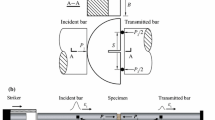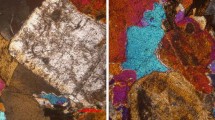Abstract
The semi-circular bending (SCB) using a split Hopkinson pressure bar system appears to be a promising method for measuring dynamic flexural strength of rock materials due to its distinct advantages. The quasi-static analysis is adopted for determining the dynamic flexural strength, of which several vital prerequisites have not been thoroughly examined yet. In this study, dynamic flexure tests regarding dynamic force equilibrium, interfacial friction effects, and energy partitioning are numerically investigated based on discrete element method (DEM) modeling. Results show that by virtue of the ramped wave loading, the force equilibrium of the specimen can be effectively achieved and the rupture is precisely measured to synchronize with the peak force, both of which guarantee the quasi-static data reduction method employed to determine the dynamic flexural strength; while the opposite occurs for the test under a rectangular wave loading. Furthermore, dynamic flexural strengths obtained by the numerical SCB tests exhibit approximately linear rate dependence that is identical with the experimental results. The interfacial friction, which is found to significantly influence the measuring results for rather high loading rates, contributes to enhancing the rate dependence of flexural strength and must be taken into account in dynamic flexure tests. In addition, energy partitioning is first numerically performed in the dynamic SCB tests and the nominal fracture energy manifests an S type of rate dependence with loading rates.
















Similar content being viewed by others
Abbreviations
- BPM:
-
Bonded particle model
- DEM:
-
Discrete element method
- ISRM:
-
International Society for Rock Mechanics
- SCB:
-
Semi-circular bending
- SHPB:
-
Split Hopkinson pressure bar
- A s :
-
Area of the fracture surface (m2)
- B :
-
Thickness of the SCB sample (m)
- F Ic :
-
Force on the incident end of the specimen (N)
- F Tc :
-
Force on the transmitted end of the specimen (N)
- G dc :
-
Fracture energy dissipated per unit area (J/m2)
- U f :
-
Accumulated energy consumed to fracture during the failure process of SCB (J)
- P 1 :
-
Axial force applied on the incident end of the sample (N)
- P 2 :
-
Axial force applied on the transmitted end of the sample (N)
- R :
-
Radius of the SCB sample (m)
- S :
-
Span of the supporting pins (m)
- t i :
-
Instant when the stress wave first arrives at the incident end of the specimen (s)
- t t :
-
Instant when the stress wave first arrives at the transmitted end of the specimen (s)
- t b :
-
Instant when the force equilibrium on both ends of the specimen is first achieved (s)
- t f :
-
Instant when the specimen initially fractures (s)
- t p :
-
Instant when the forces on both ends of the specimen reach the peak value
- t d :
-
Instant when the specimen is destroyed (s)
- t e :
-
Instant when the loading process ends (s)
- t m :
-
Instant of a post-mortem examination (s)
- εi :
-
Incident strain signal on the incident bar
- εr :
-
Reflected strain signal on the incident bar
- εt :
-
Transmitted strain signal on the transmitted bar
- μ :
-
Force equilibrium coefficient
- f :
-
Friction coefficient
References
Arabani M, Ferdowsi B (2009) Evaluating the semi-circular bending test for HMA mixtures. Int J Eng Trans A 22(1):47–58
ASTM Standard C1499-05 (2005) Standard test method for monotonic equibiaxial flexural strength of advanced ceramics at ambient temperature. ASTM International
ASTM Standard C293/C293M-10 (2010) Standard test method for flexural strength of concrete (using simple beam with center-point loading). ASTM International
ASTM Standard C78/C78M-15a (2015) Standard test method for flexural strength of concrete (using simple beam with third-point loading). ASTM International
ASTM Standard C880/C880M-15 (2015) Standard test method for flexural strength of dimension stone. ASTM International
Bohme W, Kalthoff JF (1982) The behavior of notched bend specimens in impact testing. Int J Fract 20(4):139–143
Chen R, Xia K, Dai F, Lu F, Luo SN (2009) Determination of dynamic fracture parameters using a semi-circular bend technique in split Hopkinson pressure bar testing. Eng Fract Mech 76:1268–1276
Colback PSB (1966) An analysis of brittle fracture initiation and propagation in the Brazilian test. Proc 1st Congr Int Soc Rock Mech Lisbon 1:385–391
Coviello A, Lagioia R, Novam R (2005) On the measurement of the tensile strength of soft rocks. Rock Mech Rock Eng 38(4):251–273
Cundall PA, Strack ODL (1979) A discrete numerical model for granular assemblies. Geotechnique 29(1):47–65
Dai F, Xia KW, Tang LZ (2010a) Rate dependence of the flexural tensile strength of Laurentian granite. Int J Rock Mech Min 47(3):469–475
Dai F, Huang S, Xia K, Tan Z (2010b) Some fundamental issues in dynamic compression and tension tests of rocks using split Hopkinson pressure bar. Rock Mech Rock Eng 43(6):657–666
Dai F, Xia KW, Zuo JP, Zhang R, Xu NW (2013) Static and dynamic flexural strength anisotropy of Barre granite. Rock Mech Rock Eng 46(6):1589–1602
Davies RM (1948) A critical study of the Hopkinson pressure bar. Philosophical Trans R Soc Lond Ser A, Math Phys Sci, pp. 375–457
Foster JT, Luk VK, Chen WW (2008) Dynamic initiation fracture toughness of high strength steel alloys. In: 11th International congress and exhibition on experimental and applied mechanics, vol. 3. Society for Experimental Mechanics, pp. 1414–20
Frew DJ, Forrestal MJ, Chen W (2001) A split hopkinson pressure bar technique to determine compressive stress-strain data for rock materials. Exp Mech 41(1):40–46
Frew DJ, Forrestal MJ, Chen W (2002) Pulse shaping techniques for testing brittle materials with a split Hopkinson pressure bar. Exp Mech 42(1):93–106
Hoek E (1964) Rock fracture around mining excavations. Proc. 4th Int. Conf. on Strata Control and Rock Mech New York
Hudson JA, Brown ET, Rummel F (1972) The controlled failure of rock discs and rings loaded in diametral compression. Int J Rock Mech Min Sci Geomech Abstr 9:241–248
Kolsky H (1953) Stress waves in solids. Clarendon Press, Oxford
Kubota S, Ogata Y, Wada Y, Simangunsong G, Shimada H, Matsui K (2008) Estimation of dynamic tensile strength of sandstone. Int J Rock Mech Min 45(3):397–406
Li XB, Zou Y, Zhou ZL (2013) Numerical simulation of the rock SHPB test with a special shape striker based on the discrete element method. Rock Mech Rock Eng 47(5):1693–1709
Lu FY, Lin YL, Wang XY, Lu L, Chen R (2015) A theoretical analysis about the influence of interfacial friction in SHPB tests. Int J Impact Eng 79:95–101
Lundberg B (1976) A split Hopkinson bar study of energy absorption in dynamic rock fragmentation. Int J Rock Mech Min Sci Geomech Abstr 13(6):187–197
O’Sullivan C (2011) Particle-based discrete element modeling: geomechanics perspective. Int J Geosci 11(6):449–464
Potyondy DO, Cundall PA (2004) A bonded-particle model for rock. Int J Rock Mech Min 41:1329–1364
Schuler H, Mayrhofer C, Thoma K (2006) Spall experiments for the measurement of the tensile strength and fracture energy of concrete at high strain rates. Int J Impact Eng 32(10):1635–1650
Song B, Chen W (2004) Loading and unloading split Hopkinson pressure bar pulse-shaping techniques for dynamic hysteretic loops. Exp Mech 44(6):622–627
Utili S, Zhao T, Houlsby GT (2015) 3D DEM investigation of granular column collapse: evaluation of debris motion and its destructive power. Eng Geol 186:3–16
Weatherley D, Boros V, Hancock W (2011) ESyS-Particle tutorial and user’s guide version 2.1. Earth Systems Science Computational Centre, The University of Queensland
Weerasooriya T, Moy P, Casem D, Cheng M, Chen W (2006) A four-point bend technique to determine dynamic fracture toughness of ceramics. J Am Ceram Soc 89(3):990–995
Xia K, Huang S, Dai F (2013) Evaluation of the frictional effect in dynamic notched semi-circular bend tests. Int J Rock Mech Min Sci 62:148–151
Xu Y, Dai F, Xu NW, Zhao T (2016) Numerical investigation of dynamic rock fracture toughness determination using a semi-circular bend specimen in split Hopkinson pressure bar testing. Rock Mech Rock Eng 49(3):731–745
Zhang QB, Zhao J (2014) Quasi-static and dynamic fracture behaviour of rock materials: phenomena and mechanisms. Int J Fract 189:1–32
Zhang ZX, Kou SQ, Jiang LG, Lindqvist PA (2000) Effects of loading rate on rock fracture: fracture characteristics and energy partitioning. Int J Rock Mech Min 37(5):745–762
Zhao J, Li HB (2000) Experimental determination of dynamic tensile properties of a granite. Int J Rock Mech Min 37(5):861–866
Zhao GF, Kazerani T, Man K, Gao M, Zhao J (2015) Numerical study of the semi-circular bend dynamic fracture toughness test using discrete element models. Sci China Technol Sci 58(9):1587–1595
Zhong WZ, Rusinek A, Jankowiak T, Abed F, Bernier R, Sutter G (2015) Influence of interfacial friction and specimen configuration in split Hopkinson pressure bar system. Tribol Int 90:1–14
Zhou YX, Xia K, Li XB, Li HB, Ma GW, Zhao J, Zhou ZL, Dai F (2012) Suggested methods for determining the dynamic strength parameters and mode-I fracture toughness of rock materials. Int J Rock Mech Min Sci 49:105–112
Acknowledgments
The authors are grateful for the financial support from the National Program on Key Basic Research Project (no. 2015CB057903), National Natural Science Foundation of China (no. 51374149, 51579167), and the Youth Science and Technology Fund of Sichuan Province (2014JQ0004).
Author information
Authors and Affiliations
Corresponding author
Rights and permissions
About this article
Cite this article
Xu, Y., Dai, F., Xu, Nw. et al. Discrete element simulation of dynamic semi-circular bend flexure tests of rocks using split Hopkinson pressure bar. Arab J Geosci 9, 543 (2016). https://doi.org/10.1007/s12517-016-2574-8
Received:
Accepted:
Published:
DOI: https://doi.org/10.1007/s12517-016-2574-8




